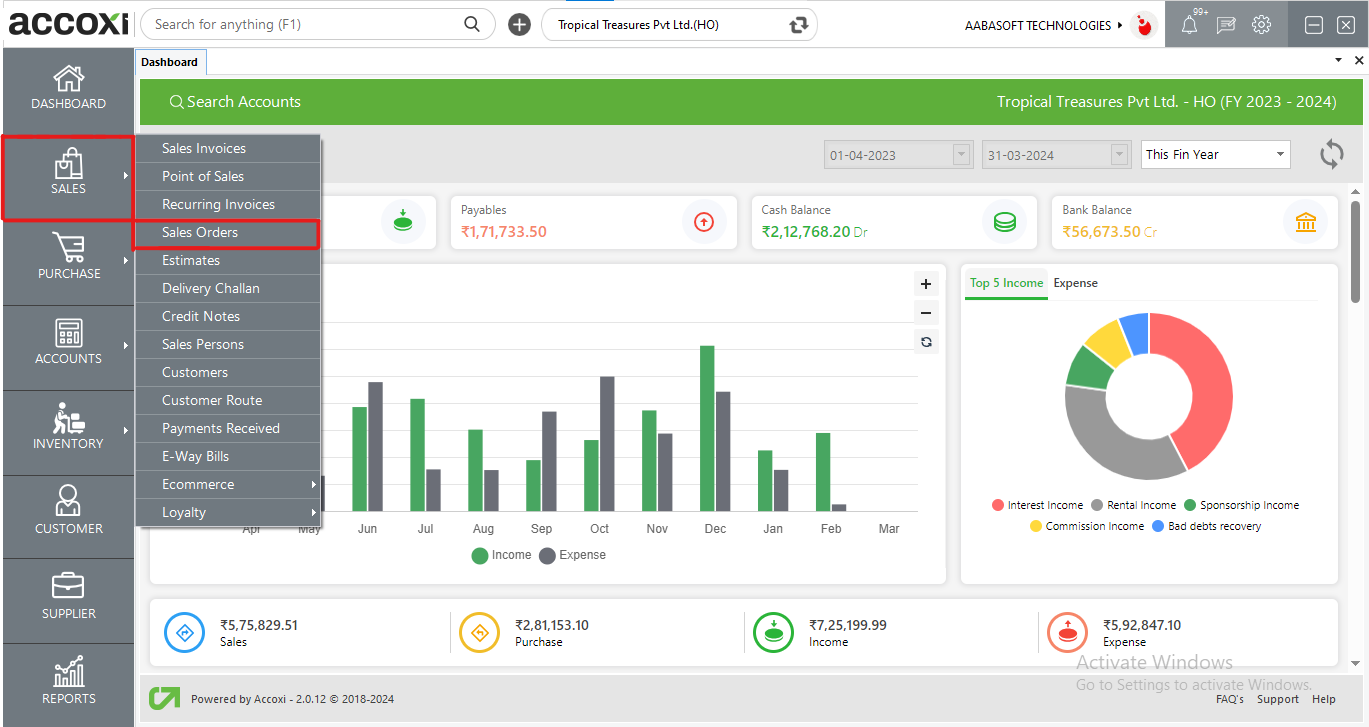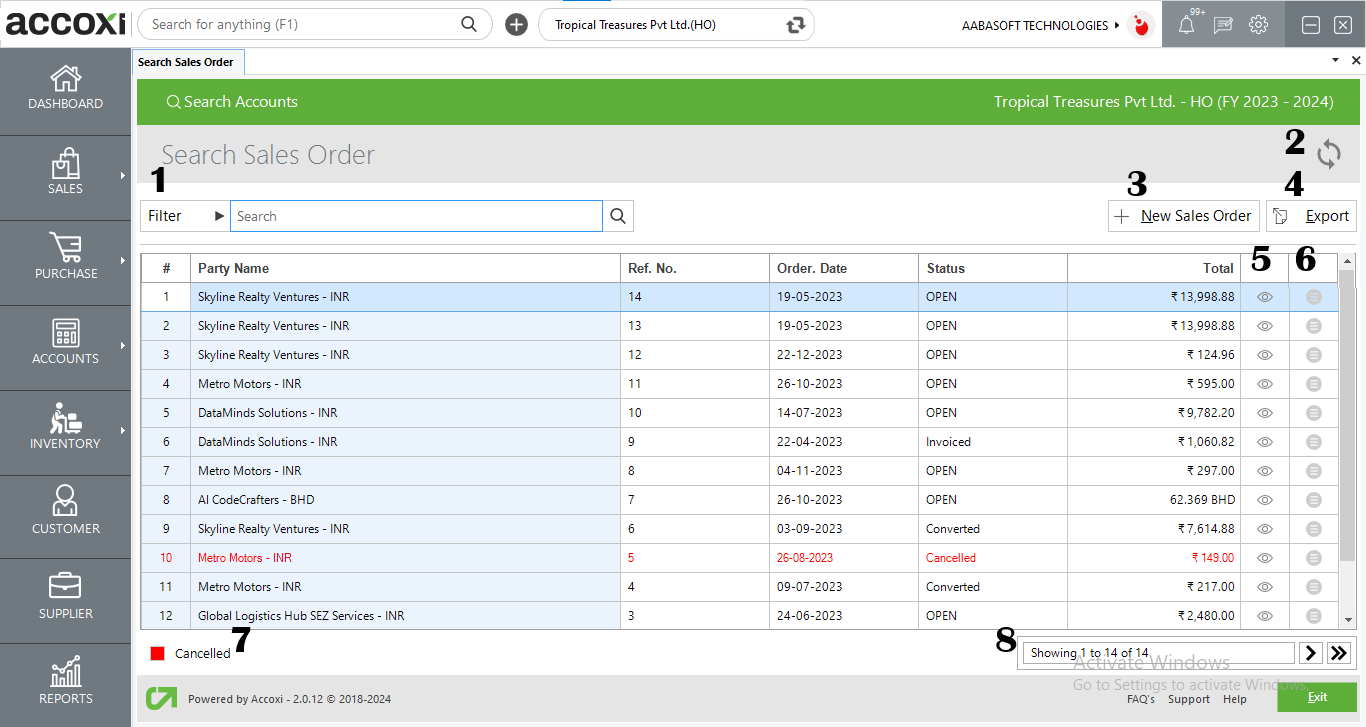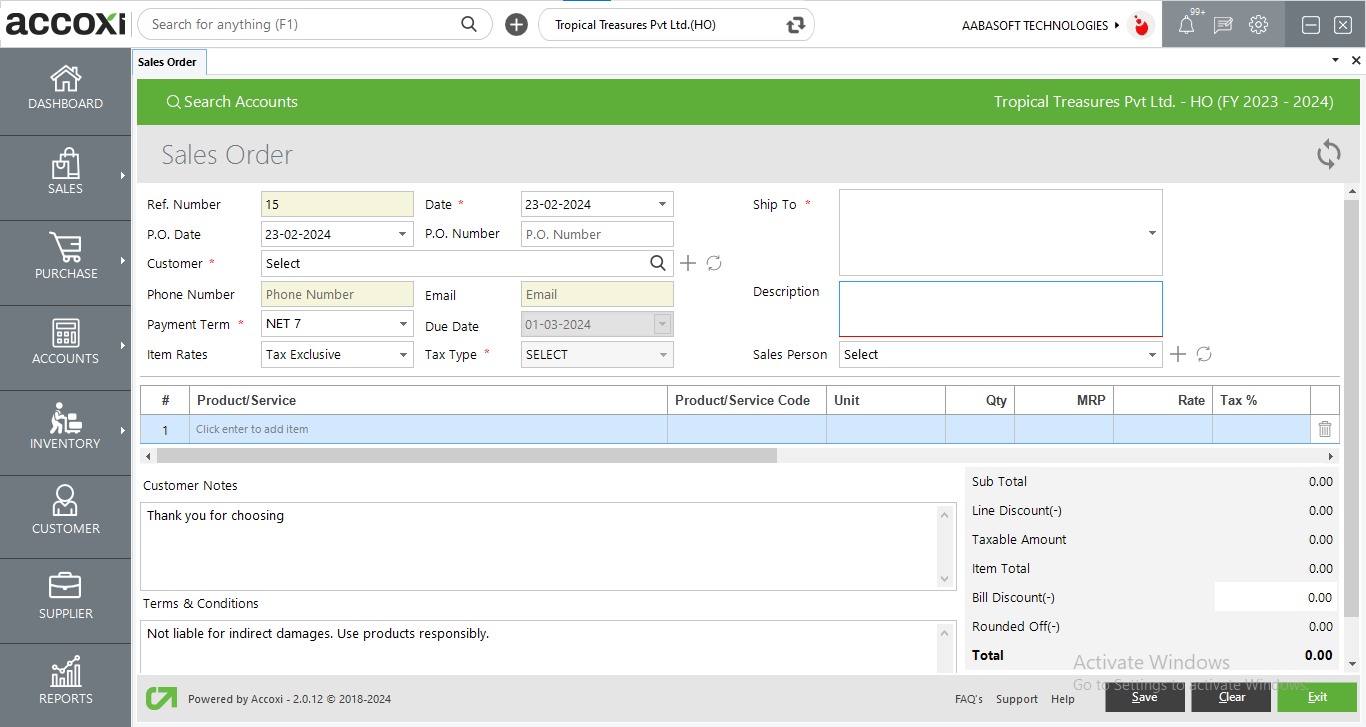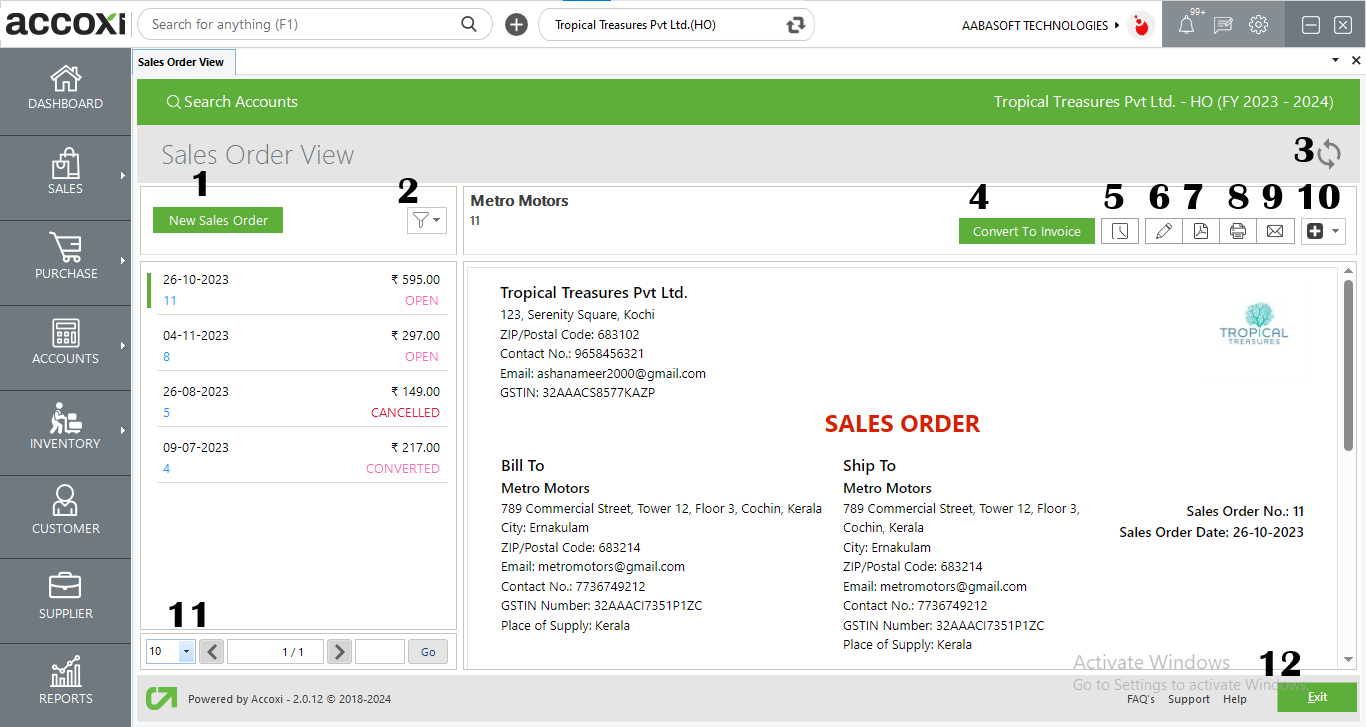
learn how to create and navigate through Sales orders in Accoxi

The sales order, sometimes abbreviated as SO, is an order issued by a business or sole trader to a customer. A sales order may be for products and/or services. In accoxi, the user can create or record Sales order and also can convert the Sales orders into Sales invoices or can convert the Sales Order into Purchase Order. The user can create a Sales order for products and services.
Key Feature of Sales Order

Click the Sales module and select Sales Order.
When we click on Sales Order menu, it opens in to Sales order search.
Sales Order Search
Sales order search consists of various menus and it shows the details of all the Sales orders that created by the user.

1. Filter
The filter option in sales orders allows the user to easily identify their sales order. Filtering is done in the following ways; by mentioning the reference Number or the name of the party of the sales order, By time frames where the user can select date intervals or can filter invoices based on the status of invoice being all, Invoiced, open and canceled.
2. Refresh
If the latest data is not displayed, click on the refresh icon on the top left corner of the page to fetch the new data.
3. Add New Sales Order
This menu is used for the purpose of creating a new Sales order. By clicking Add new + Sales order, a new window opens with the new form of Sales order.
Steps to create New Sales Order

|
Fields |
Description |
|
Reference number |
Reference number helps the user to identify transactions in records. It will automatically appear on the Sales order form and the user can’t edit the reference number, as it will be the continuation of the previous order. |
|
Date |
The date will automatically appear on this field and it may be the current day date. If the user wants to change the date, it can be done by clicking on the date menu and can select the required date. |
|
Customer |
Select the customer to whom the user wants to sell the products or services. By clicking the select menu, a list of customers will appear and the user can select the required customer from the list. If the user wants to create a new customer without the list, can create a new customer by clicking the menu + (add new). When the user selects a customer, then the fields of the phone number, email, GSTIN are automatically filled. |
|
Phone number |
When the user selects the customer, the phone number details of the customer will be automatically filled in this field. |
|
|
It shows the email id of the selected customer. The user can’t enter anything in this field. |
|
Description |
Users can add an additional explanation if required. |
|
Tax Type |
This field shows the type of sale on the basis of location. It may be Local or Interstate. The user can’t enter or edit anything on this field. This field is automatically filled when choosing a customer |
|
Payment term |
Select the payment term here and in some cases, it will appear automatically on the field. It's because when the user creates a customer account, can also save the payment term option. So when the user selects the customer, the payment term will also appear along with that (can edit if require). |
|
Due date |
The due date is the date on which the payment is expected or due. When the user sets the payment term of a customer, then the due date will automatically appear on the field. Users can’t edit or delete the date on this field. |
|
Product/Service |
Select the product or service here, that needs to create a sales order. When the user selects an item, then its rate, MRP, tax amount, HSN code, and unit details will automatically appear with that. Users can edit the rate IF require and can enter the quantity of the item. |
|
Product or service code |
Select the product or service here, that needs to create a sales order. When the user enters the product name, needs to press Enter and then the batch will appear on the product and enter the batch also. After entering the product and batch, the rate and other details will appear in the field. |
|
HSN/SAC |
HSN/SAC code will appear after entering the product and batch details on the product field. |
|
Unit |
Unit of the product will automatically appear on the field only after selecting or entering the product. The user can’t enter or edit the unit on the field. |
|
Batch |
Users can enter the batch number of the product or service in this field. |
|
Description |
The product description if any can be written down here |
|
Quantity |
Need to enter the quantity of the product in this field. |
|
MRP |
MRP of the product will automatically appear on the field after selecting the product for making Sales order. The user can’t edit the MRP of the product as it is already fixed. |
|
Rate |
The sales rate of the product will automatically appear on the field after selecting the product. The user can’t edit the rate on the field. |
|
Tax% |
This field automatically shows the tax rate of the Selling item. It may be 3%, 5%, 12%, 18%, 28%, nil rated, exempted or no GST. Users can’t edit or enter the rate on this field. |
|
Taxable amount |
The taxable amount is the amount on which tax is to be charged. It will automatically appear after entering the rate details. |
|
Tax amount |
The tax amount is the amount at which a business or person is taxed on the basis of tax type Inclusive or Exclusive. |
|
Cess amount |
It is a form of tax charged/levied over and above the base tax liability of a taxpayer. Users need to enter the cess amount in this field. |
|
Item Total |
After entering the details of the Sale item that as product rate, tax rate, etc user gets the gross amount of the item total. |
|
Item rates |
This menu includes Inclusive and Exclusive tax rates. Users can select any one of the tax rates from this, and the product/ service tax will be calculated on the basis of the selected tax rate. |
|
Sales Person |
If the user wants to select a salesperson for the concerned product or service, it can be done by using the menu Salesperson. By clicking on the menu, the salesperson list will appear and the user can select the concerned salesperson. If the user wants to create a new salesperson, it can be also done on the page. By clicking the + (add new) menu user can create a new salesperson. |
|
Discount |
Users can enter the discount rate on the right side of the page. There are four types of discounts that are available in the sales module. They are discount before tax, discount after-tax, line discount, and no discount. Users can set the discount type from the sales settings and can enter the discount. |
|
Round off |
Rounding numbers make it simpler and easier to use. Users can round off the total amount by using this field and the roundoff may be downward, upward, and nearest. This can be selected from the preference menu in organization settings. |
|
Customer Note |
The customer note can be given in this area |
|
Terms and Conditions |
The terms and conditions of the sales order can be added here |
|
Save |
Click on the Save menu to save the details that were entered and to create a sales order. |
|
Clear |
A clear menu is for clearing or removing the entire data entered by the user. |
|
Exit |
A clear menu is for clearing or removing the entire data entered by the user. |

|
Fields |
Description |
|
1. New Sales Order |
It is the menu option to create a new sales order. By clicking the New Sales order, the user gets a new form to create a new order. |
|
2. Filter |
The filter menu enables the user to filter the data and the data filter on the basis of Order status, open order, canceled, invoiced, or all. |
|
3. Refresh Option |
If the latest data is not displayed, click on the refresh button to fetch new data |
|
4. Convert to Invoice |
After creating the sales order, the user can instantly convert the Sales Orders into invoices by clicking on the 'Convert to Invoice' on the top right side of the window. This will redirect the user to the sales invoice window. All the data of the sales order has been automatically filled in the invoice window and the user needs to click the save option to generate the invoice. After converting the sales order into an invoice, the sales order status will change from Open to Invoiced. |
|
5. History |
This menu helps the user to obtain the history details of the Sales Order. There are two tabs in the Sales order history. They are, Comments & history and Created invoice.
|
|
6. Edit |
Edit menu helps the user to edit or correct the details that are entered in the sales order and can save again after it. When clicking on the edit menu, the screen will go to the previous window of the new sales order form. |
|
7. Export to PDF |
This menu enables the user to export the Sales order form to PDF format and can save it in the system. When the user clicks on the PDF menu, a new tab will appear to save the file. Then the user can select the location to save the file, can set a name, and click on the save button to save the file in PDF format. |
|
8. Print |
If the user wants to take the printout of the created sales order form, it can be done by using the menu Print on the top right side of the order view. When the user clicks on the print menu, a new tab will appear on the screen and it contains the details regarding the print. Users can set the page range, page height, and width and can enter the required number of copies here. By clicking on the Print button, the user gets the printout of the sales order form. |
|
9. Email |
The email menu enables the user to send the Sales order form directly to the suppliers. By clicking on the Email menu, a new tab will appear regarding the details of sending mail. It includes To id, CC, subject, and content. When clicking on the email menu, the email id of the Supplier will automatically appear on the TO field. If the user wants to change the email id then it can be done by removing the id and can enter a new one. Users can also enter CC if require and can add an additional description if required. If the user wants to change the Email template, it can be done by Email template in Settings. Need to mark the option attachment for sending the sales order form by Email. After clicking on the Send option, the mail will send to the selected supplier. |
|
10. More options |
More options menu is on the top right side of the screen, and it includes the options for converting to purchase order, creating duplicate, and Canceling order. If the user wants to create a duplicate copy of the sales order, then it can be done by selecting the option of Create Duplicate from the More options menu. Users can convert the Sales Order into Purchase Order and if the user wants to cancel the created order then it can be also done by this menu. |
|
11. pagination control |
It controls the page navigation and the page size. Page size can be set to 10, 20, 50, or 100. And by giving the page number in the box and clicking on the Go button. It jumps to the said page. |
|
12. Exit |
If you want to exit from the current page. Click on the exit option |
4. Export
The sales order list can be exported to Excel format. Click the Export button at the top right corner near the +New button. Select the file location and click on save
5. View
View menu enable the user to view the sales order form that already created.
6. More Settings
This menu includes options to edit, view, export to PDF, and print the sales order.
Edit menu helps the user to edit or correct the details that are entered in the sales order and can save again after it. When click on the edit menu, the screen will goes to previous window of new sales order form.
View menu enables the user to view the Sales order form that already created.
This menu enables the user to export the sales order form to PDF format and can save in the system.
If the user want to take the print out of the created sales order form, it can be done by using the menu Print on the top right side of the order view.
7. Canceled Order
User can easily identify the cancelled sales order by using color format. Cancelled orders are indicates with red color.
8..Pagination Control
It controls the page navigation and the page size. Page size can be set to 10, 20, 50 or 100. And by giving page number in the box and clicking on Go button. It jumps to the said page.
Filter option is available below the sales order search bar at the left hand side. Sales order can be filtered based on party name, ref.no. Status etc. Either you can give any of the said criteria directly into the search bar near filter option or by clicking the filter down arrow option you can give the details into the fields directly.
There are two tabs in the Sales order history. They are,
Comments & history and Created invoice.
Yes. You can export the Sales Order data in to Excel format. It can be done by the following steps;